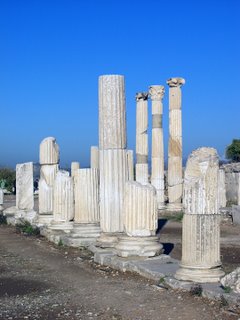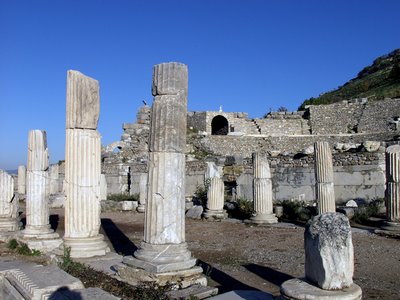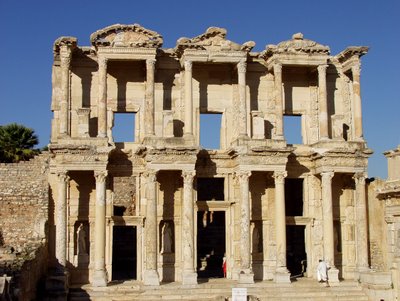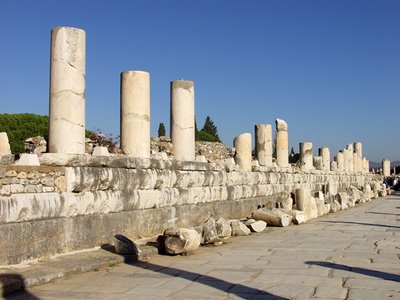
EPHESUS in Turkey is known to the Western World mainly as the place where the Apostle Paul spent two years trying to persuade people that Christianity was a more effective religion than their devotion to the Goddess Diana. The story of his stay there, including his being thrown in jail for causing a disturbance, can be found in the 19th Chapter of “The Acts of the Apostles.”
 Archeological evidence indicates that Ephesus was founded before 200 B.C.E. and that by 3 B.C.E. was one of the largest and most important cities in the world. The city died when the river flowing into the Aegean Sea silted up the port turning the area into a vast marshland. Mosquitos brought malaria. The city had been abandoned by the 11th century A.D.
Archeological evidence indicates that Ephesus was founded before 200 B.C.E. and that by 3 B.C.E. was one of the largest and most important cities in the world. The city died when the river flowing into the Aegean Sea silted up the port turning the area into a vast marshland. Mosquitos brought malaria. The city had been abandoned by the 11th century A.D.

During the Roman period Ephesus was the capital of proconsular Asia which covered the western part of Asia Minor. A stroll among the ruins is a trip back in time, a walk through Greek and Roman streets. You are on a street that was once surrounded by a colonnade and shops. The agora, or marketplace, the heart of Ephesus’ business life is being restored.




The facade of the Library of Celsus is remarkably intact. The library held 12,000 scrolls in niches around its walls. The building was planned so well that a gap between outer and inner walls protected the valuable books from extremes of temperature and humidity. The library now stands alone, but it once upon a time took its place between other buildings. Architectural legerdemain was used to make it look bigger than it is: the base of the facade is convex, adding height to the central elements; and the central columns and capitals are larger than those at the ends. Gaius Julius Celsus Polemaeanus was the Roman governor of Asia Minor early in the 2nd century A.D. In 110, after the governor’s death, his son, Consul Gaius Julius Aquila, erected this library in his father’s honor; as says an inscription in Latin and Greek on the side of the building’s front staircase. The statues that once stood in the niches on the facade representing the Virtues: Arete (Goodness), Ennoia (Thought), Episteme (Knowledge) and Sophia (Wisdom) are now in Vienna’s Ephesus Museum.


Strolling among the ruins, one easily finds the monumental Gate of Augustus and Curetes Way. The Odeon was used for poetry-readings, small concerts and prize-giving ceremonies. In Hellenistic times, theaters and odeons were as important as temples in the life of the citizens. For the Romans who came later, a good time was a matter of feasting, playing games and enjoying spectacles. The cry for "bread and circus" was common in the Roman period. The Odeon was built into the side of the hill and could seat thousands of people.



The Turkish town of Selcuk is up the road from the site of Ephesus, and the nearest active Turkish port is at the city of Kasadusi.

No comments:
Post a Comment